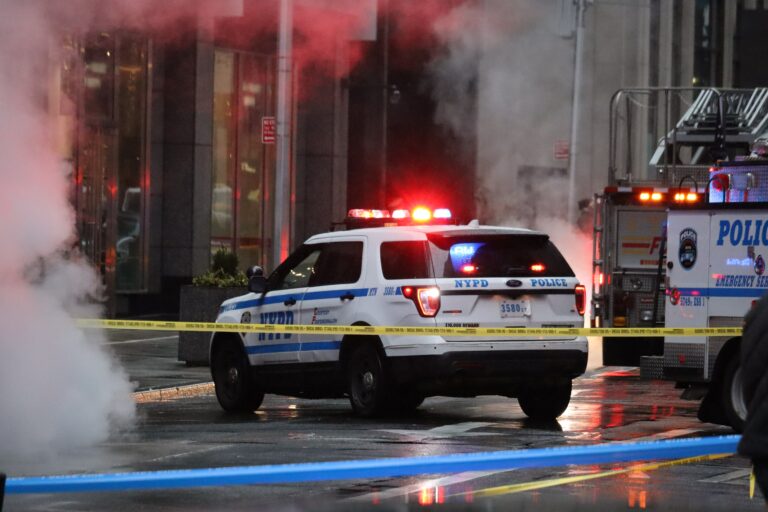There hasn’t been a mass shooting so far this year, but that doesn’t necessarily mean we’ll see fewer than in recent years.
As of April 18th, The Violence Project (VP) hasn’t identified any mass shootings in 2024. That means there haven’t been any public shootings unrelated to gang or criminal activity where four or more people were killed.
It comes as preliminary data shows the murder rate has continued to fall through the beginning of the year as well. The same is true for all of the broader definitions of mass shooting employed by the Gun Violence Archive (GVA).
Everything shows a downward trend.
That’s not so surprising when it comes to the broader counts. This is especially true for the Gun Violence Archive, whose count includes any incident where four or more are injured and has fallen about 30 percent compared to the same time in 2023. Its count is probably dropping for the same reason critics say it’s a poor gauge of mass shootings: the low bar it uses tends to capture lots of events that most people wouldn’t recognize as mass shootings and are more like everyday violence.
Since the GVA count captures a lot of gang or street crime and a larger chunk of overall murders, it makes sense it would track closer to the general murder rate. However, the GVA count has actually risen at a much faster rate than the overall murder rate. It also didn’t decrease alongside 2023’s murder rate drop but now seems to be catching up as the number of GVA incidents is falling faster than the murder rate.
Part of that could have to do with the fact that GVA uses media reports to track shootings where four or more are injured, which may lead to incidents being missed or misreported. In fact, the publicity GVA has brought to these kinds of attacks may even have made coverage of them, or at least outlets emphasizing the victim counts involved, more common in and of itself.
Either way, a count that captures many more shootings should more closely reflect the overall level of American violence than more restrictive counts. A significant drop in all shootings and murders ought to result in fewer GVA incidents at scale.
The same isn’t necessarily true for the kind of mass shootings the VP count tracks. Since the VP definition filters out more common attacks with criminal motivations, it captures events that are much more distinct from other forms of gun violence. That makes its count a lot more in line with what most Americans likely imagine when they think of mass shootings, and those events are uniquely resistant to overall violence trends.
That’s why the absence of mass shootings through April could just be a mirage. Mass shootings happen in a fairly unpredictable pattern. It’s not that unusual to go months between mass shootings only to have two or three occur in quick succession.
That clustering has been the topic of debate for years. Some argue it’s evidence of a short-term contagion effect, while others say it’s just the result of randomness in a small sample size. In fact, the random and sporadic nature of the shootings makes any short-term trends in mass shootings hard to scrutinize.
“I’ve always found the more restrictive definition of a mass shooting to be too…restrictive…making it hard to know what any changes mean,” Jeff Asher, a crime analyst at AH Datalytics, told The Reload. “I’d say that the base rate of these types of incidents is so low that randomness could be responsible for any change from year to year.”
To this point, 2022 didn’t see a mass shooting until May 14th. Then, it experienced three within a month, including the horrendous Uvalde shooting. That year saw seven mass shootings before it was over, according to the VP count.
One of the most remarkable things about mass shootings is how stable their frequency has been over the years. Since 2017, VP’s database shows every year has seen between seven and nine mass shootings. The lone exception was 2020, when lockdowns and social distancing policies made large public crowds rare.
That’s surprising, considering a shooting only gets counted when an attacker manages to kill at least four people. There are a lot of variables that contribute to whether somebody trying to carry out a mass shooting can actually do so. The FBI’s most recent active shooter report bears that out. Fewer attempts were made to shoot groups of people in public spaces in 2022 than 2021, but more resulted in mass killings and more people were killed overall.
Further, the FBI’s count of active shooter incidents in recent years shows very little correlation to the number of mass shootings in the VP database.
The same is true for the murder rate. There’s very little connection there, either. So, it is hard to predict whether the falling murder rate or the recent lack of mass shootings means we’ll see fewer horrific acts of spectacular violence by the end of the year.
But we can certainly hope that’s the case. And, if it does turn out that way, perhaps it will give us some new insight into how to prevent mass shootings moving forward.






